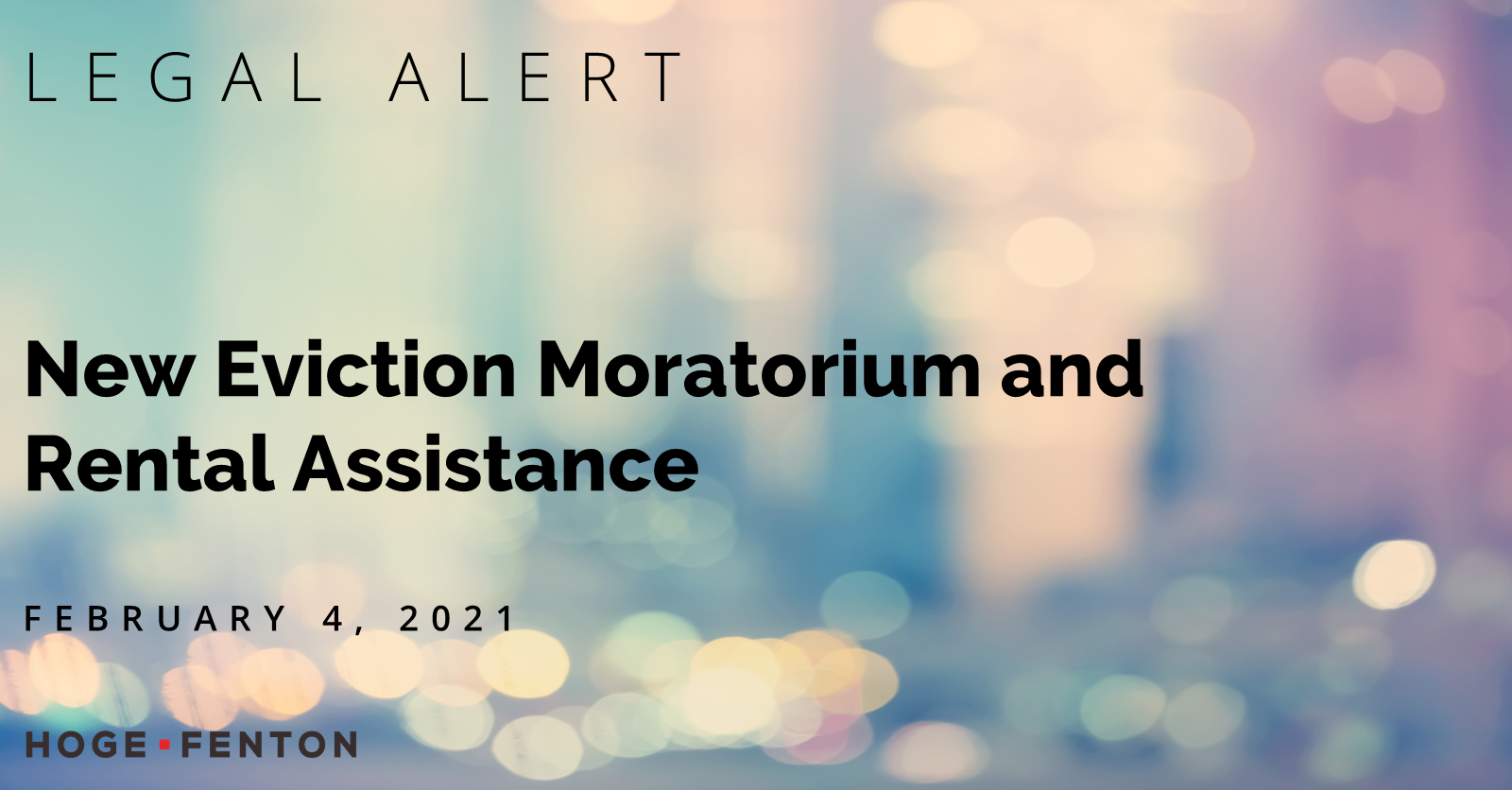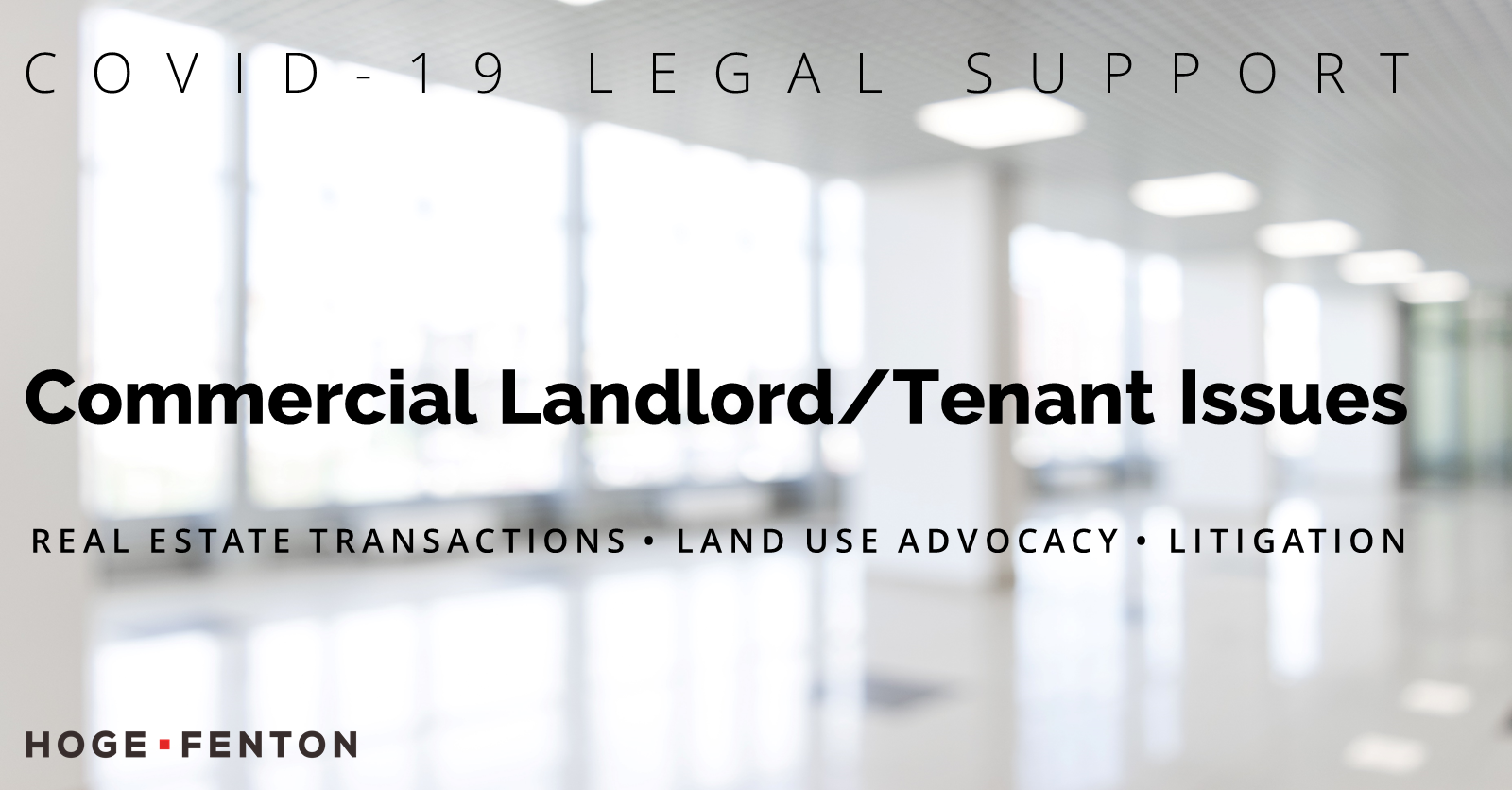Additional Resources |
03.22.2021 | Firm Post

In a coordinated effort between the federal government, the State of California, and local jurisdictions, tenants and landlords can now apply for rental assistance. This is excellent news for all. The funds are intended to mitigate debt owed to landlords by residential tenants who remained housed but did not pay some or all of their rent due to COVID-related hardships, as provided by eviction protections laws.
This article discusses:
- Program Overview
- Who is Eligible
- How to Apply
- Expenses that Qualify for Reimbursement
- Landlord-Tenant Cooperation on Applications
- Additional Applications
Program Overview
Pursuant to Senate Bill 91 (“SB-91”), the State of California and various local jurisdictions implemented an application process for landlords and tenants to receive reimbursement funding for up to 80% of the missed rent owed during the April 1, 2020, and March 31, 2021 time period.
In exchange for the 80% in reimbursement, landlords must agree to waive their rights to collect the remaining 20% and must promise not to sue their tenants for this 20% remainder.
Landlord participation in this program is optional. If a landlord does not participate in the Rental Assistance Program, tenants can still apply and participate and the State will pay them amounts equal to 25% of their back-owed rent.
While the Rental Assistance Program is optional, if landlords later sue the tenant for damages based on the tenant’s rental arrears without participating, judges in those cases do have the discretion to make a finding on how much the landlord’s requested rent was available to the landlord via the Program and could reduce the landlord’s damages based on the funding available via this program.
An important consideration for landlords:
Those who choose not to participate in the Rental Assistance Program, and later sue tenants for nonpayment of rent damages, risk reduced recovery. This is because judges in those cases have the discretion to reduce the landlord’s damages by the amount of rent recovery available to, but declined by, the landlord.
Where to Begin?
The State of California’s “Housing is Key” website should be the starting point for applications. Depending on the jurisdiction, applicants should either apply through the State of California or through a local jurisdiction’s process. The website directs applicants to the appropriate application for their jurisdiction.
The State will prioritize funding for tenants who suffer the most vulnerability to homelessness, focusing first on households earning less than 50% of their Area Media Income, then on households disproportionately impacted by COVID-19, and then on all households earning less than 80% of the Area Media Income (AMI).
Please note that some jurisdictions, such as San Francisco County, received federal funding to implement their own programs separately from the State of California. Other jurisdictions may choose to implement their own programs, rather than administering it through the State of California. Applicants in these jurisdictions are cautioned to expect delays in receipt of funding while officials work to avoid duplicative payments.
Who is Eligible to Apply?
Both landlords and tenants are eligible to apply, however, there are different criteria for each.
Landlord Eligibility Requirements:
- All payments must be used to satisfy tenants’ unpaid rent for the period between April 1, 2020, and March 31, 2021.
- Tenants must take steps to verify that they meet eligibility requirements and sign the application.
- Tenants’ household income must be at or below 80% of the Area Median Income.
- Tenants must certify that they have not defaulted in any way under their lease or rental agreement, other than the nonpayment of rent.
- Tenants must also promise to resume making rental and utility payments starting on the first dates after those covered under the program, or to reapply for the rental assistance program for more assistance.
Importantly, the application requires that landlords wait at least 60 days after the last month the landlord received funding before the landlord can file a lawsuit for any future nonpayment of rent or nonrenewal of the lease. For example, if a landlord participates in the Rental Assistance Program and receives funding amounting to 80% of rental arrears due from April 1, 2020, through March 31, 2021, the landlord must wait until at least May 31, 2021, to file a suit in unlawful detainer or damages for the nonpayment of rent for the April 2021 or May 2021 time period.
The landlord must also agree:
- That the landlord knows of no reason, except nonpayment of rent, that would justify a lawsuit for unlawful detainer or damages.
- Not to evict the tenant for any nonpayment of rent owed before April 1, 2020.
Note that landlords may sue for nonpayment of rent damages starting July 1, 2021, so long as tenants who have COVID-19 related hardships timely provide a declaration certifying they have financial distress for each rental period.
Useful Resources for Landlords
Tenant Eligibility Requirements:
- Have qualified for unemployment benefits or experienced a reduction in household income, incurred significant costs, or experienced other financial hardship due to COVID–19.
- Demonstrate a risk of experiencing homelessness or housing instability, which may include: (a) a past-due utility or rent notice or eviction notice; (b) unsafe or unhealthy living conditions; or (c) any other evidence of such risk, as determined by the program.
- Have a household income that is not more than 80% of the Area Median Income. The online Rental Assistance Application calculates this for the applicant.
Useful Resources for Tenants:
How to Apply for the Program
Landlords and tenants can apply online via the Housing is Key website.
Applicants can also apply via phone at (833) 430-2122 from 7:00 AM – 7:00 PM Pacific time Monday through Sunday.
Applicants may apply through Local Partner Networks: organizations in several local communities who can schedule appointments or home visits (in limited circumstances, such as an applicant having a disability) with applicants who need hands-on assistance.
Expenses that Qualify for Reimbursement
The 80% reimbursement will include more than just rent; other reimbursable expenses include utilities owed and incidental charges such as parking if the tenants were required to pay these costs under their rental agreements.
While the State will directly pay the reimbursement for missed rent to landlords, California designates tenants as the “benefitted” party, and payments received under this funding must be applied to that tenant’s back-owed rent.
Cooperation Between Landlord and Tenant Applicants
The State encourages landlords and tenants to cooperate on the application so that the greatest amount of eligible applicants can be served, as this is the best chance for parties to meet their outstanding rent obligations. Without tenant participation, the State cannot verify the “need” which makes the tenant eligible for assistance.
Tenants who submit their application will receive a reference number to send to their landlords to integrate the application. Similarly, landlords who submit their application will also receive a reference number to send to tenants for use in their applications.
Each party will be able to privately submit their supporting documents without the other having access, including w9s for landlords and proof of financial distress for tenants.
Will additional applications be available for local jurisdictions?
Some jurisdictions, such as the City of Los Angeles, San Francisco City, and County, and Sacramento are administering their own rental assistance program separate from the State of California’s. The local programs may not yet be available.
Organizations including the California Apartment Association and the National Low Income Housing Coalition created handy guides to assist program applicants:
Will there be additional funding and programs in the future?
Funding for the current rental assistance program comes from the $2.6 billion in federal rental assistance allocated to California in December of 2020. Now that President Biden signed a new stimulus package, the American Rescue Plan, in March of 2021, Californians can soon expect more federal rental assistance to come from an additional $2.2 billion in emergency federal funds.
Landlords, tenants, and homeowners should expect the State of California to announce its programs to administer this additional funding soon.
For additional resources regarding COVID-related laws applicable to landlords and/or tenants, please refer to Hoge Fenton’s Real Estate and Land Use resource page (here) and do not hesitate to contact a member of the Real Estate and Land Use Group.
Our Real Estate and Land Use Attorneys
 |
Giuliana Ferrante is an accomplished litigator in the firm’s Real Estate and Land Use Group. Giuliana represents clients through all stages of litigation from case evaluations to appeals. Her practice focuses on handling intricate appellate matters, business litigation, insurance coverage, insurance bad faith claims, and other commercial disputes. |
 |
Steven Kahn is a Shareholder and Chair of the Real Estate and Land Use Group who balances litigation skill with a strategy to achieve his clients’ goals and protect their interests. He focuses on real estate disputes and litigation. Steven represents clients throughout Northern California, including individuals, families, trusts, real estate professionals, insurers, municipalities, and businesses of any size, private or public. |
This information is provided as an educational service by Hoge Fenton for clients and friends of the firm. This communique is an overview only, and should not be construed as legal advice or advice to take any specific action. Please be sure to consult a knowledgeable professional with assistance with your particular legal issue. © 2021 Hoge Fenton
02.04.2021 | Firm Post

Federal Funds Now Available for Back-Owed Rent; California’s Qualified Residential Eviction Moratorium Extended Again
Landlords MUST Notify Tenants of the New Law By February 28, 2021 to Preserve Landlords’ Right to Relief
by Giuliana Ferrante and Steven Kahn
COVID-19 is, tragically, far from over. In response, California recently extended its qualified statewide residential eviction moratorium to June 30, 2021. The new law, SB 91, replaces California’s COVID-19 Tenant Relief Act of 2020 (AB 3088 / “the Act”), signed by Governor Newsom on August 31, 2020, and adds several new features beneficial to both landlords and tenants.
AB 3088 originally protected residential tenants from eviction if those tenants declared under penalty of perjury that they suffered economic hardships related to COVID-19 and paid at least 25% of their total rent due by January 31, 2021. Covered tenant hardships include, but are not limited to: the loss of a job, or the need to care for a family member with severe COVID-19 symptoms.
SB 91 extends residential tenants’ protection from eviction from January 31, 2021 to June 30, 2021, after which landlords can either: (1) file unlawful detainer (eviction) lawsuits against tenants who do not pay the minimum 25% of total rent due; or (2) sue for monetary “civil debt” in small claims court for the amount of rent owed, even if that amount is higher than the usual small claims maximum.
SB 91 also provides instructions for allocating $1.4 billion in federal emergency rental assistance funds: soon, landlords providing housing to residential tenants have the option to apply for government funding covering up to 80% of rent accumulated during the specified period of April 1, 2020 and March 31, 2021, for tenants who demonstrated they could not pay their rent due to the COVID-19 pandemic.
Eviction Moratorium – Qualified and Extended
In order to preserve their rights to seek damages and pursue unlawful detainer lawsuits against non-paying tenants after the expiration of the eviction moratorium on June 30, 2021, and their rights to apply for missed rent assistance, landlords must follow these procedures:
- No later than February 28, 2021: Provide tenants who missed rent payments between April 1, 2020 through February 1, 2021 with an informational notice of the extension of the Act and the establishment of the rental assistance program. An example of this notice prepared by the California Department of Real Estate is available at this link. Landlords who do not timely provide this notice cannot serve tenants with a 15-Day Notice to Pay Rent or Quit (described below).
- Each time a tenant fails to pay the rent due for a rental period (typically the first of the month), serve the tenant with:
- (1) a “Notice from the State of California” – An example of this notice prepared by the California Department of Real Estate is available at this link.
- (2) a blank “Declaration of COVID-19-Related Financial Distress” – An example of this notice prepared by the California Department of Real Estate is available at this link.
- (3) a “15-Day Notice to Pay Rent or Quit” – An example of this notice prepared by the California Department of Real Estate is available at this link.
- If the landlord has information on file that the tenant is a “high-income tenant” who makes over 130% of the median income in that county, they may request additional information proving the hardship. An example of this notice to be used in this circumstance prepared by the California Department of Real Estate is available at this link.
Residential tenants cannot be evicted by their landlords until July 1, 2021, only if those tenants adhere to the following procedures:
- Use the declaration form provided by the landlord to declare under penalty of perjury that the tenant has a covered hardship caused by the COVID-19 pandemic;
- Return that sworn declaration to the landlord within 15 days of receiving a “Notice to Pay Rent or Quit” and the applicable “Notice from the State of California” served by the landlord;
- Pay at least 25% of their total rent due between September 1, 2020 and June 30, 2021, no later than June 30, 2021.
Rental Assistance
SB 91 allows landlords to apply to the State of California for reimbursement of up to 80% of past due rent owed by tenants from April 1, 2020 through March 31, 2021, payment of which will come from federal funds. Landlords who receive these State Rental Assistance funds must agree to forgive the tenant’s remaining debt from the April 1, 2020 through March 31, 2021 period and forego any claim for unlawful detainer arising out of unpaid rent from that period. In other words, Landlords will be paid 80% of unpaid rent accrued from April 1, 2020 through March 31, 2021 in exchange for not evicting tenants for unpaid rent during that period.
If a landlord does not participate in the State Rental Assistance Program, the tenant can apply to the State of California for assistance covering up to 25% of their unpaid rent from April 1, 2020 through March 31, 2021. More federal funding may become available to assist with future rental payments.
SB 91 requires the State Rental Assistance Program to accept applications no later than March 15, 2021. Plan administrators have not released details on the application process or instructions to apply. Localities with over 200,000 residents will receive the emergency funding directly, and those local governments will oversee the application process. Organizations including the California Apartment Association anticipate that the application will include information such as the tenant’s proof of income and proof of hardship.
Local Law
Under both the Act and SB 91, landlords can still evict tenants for certain “just cause” reasons – i.e. other than nonpayment of rent – including for issues of health and safety, or if the landlord elects to remove a unit from the rental market. However, landlords should take caution that local eviction moratoriums may offer stronger protections than the State law. For example, several Bay Area cities, including Berkeley, Oakland, and San Francisco, enacted stronger tenant protection laws in response to COVID-19.
While the Act and SB 91 prevent localities from extending or changing their moratoriums, any local moratorium in place on or before August 19, 2020 will remain in effect through the date the local law itself set out for its expiration.
More information about the COVID-19 Tenant Relief Act, SB 91, and the rental assistance programs, including more information about how to qualify for assistance, can be found at the California Department of Real Estate’s website or by calling 1-833-422-4255. The California Department of Real Estate’s tenant forms can found here and landlord forms can be found here.
Have a dispute with a residential or commercial landlord/tenant?
Contact our Real Estate and Land Use Group here.
Our Real Estate and Land Use Attorneys
 |
Giuliana Ferrante is an accomplished litigator in the firm’s Real Estate and Land Use Group. Giuliana represents clients through all stages of litigation from case evaluations to appeals. Her practice focuses on handling intricate appellate matters, business litigation, insurance coverage, insurance bad faith claims, and other commercial disputes. |
 |
Steven Kahn is a Shareholder and Chair of the Real Estate and Land Use Group who balances litigation skill with a strategy to achieve his clients’ goals and protect their interests. He focuses on real estate disputes and litigation. Steven represents clients throughout Northern California, including individuals, families, trusts, real estate professionals, insurers, municipalities, and businesses of any size, private or public. |
This information is provided as an educational service by Hoge Fenton for clients and friends of the firm. This communique is an overview only, and should not be construed as legal advice or advice to take any specific action. Please be sure to consult a knowledgeable professional with assistance with your particular legal issue. © 2021 Hoge Fenton
09.23.2020 | Firm Post

RESIDENTIAL LANDLORDS REQUIRED TO SEND TENANTS NOTICE BY SEPTEMBER 30, 2020
OR MAY WAIVE THE RIGHT TO EVICT OR SEEK UNPAID RENT LATER
by Giuliana Ferrante, Attorney, Real Estate & Land Use Group
On August 31, 2020, Gov. Gavin Newsom signed AB3088, providing a framework for California’s residential landlords to preserve their rights to later claim unpaid rent and/or evict tenants for unpaid rent, while protecting tenants who have demonstrated financial hardship arising out of the COVID-19 pandemic. Under AB3088, landlords intending to seek damages from residential tenants who have missed rent between March 1, 2020 and August 31, 2020 MUST SEND THE “COVERED PERIOD” NOTICE ON OR BEFORE SEPTEMBER 30, 2020, OR THE RIGHT TO EVICT OR SEEK UNPAID RENT AT A LATER TIME MAY BE WAIVED. [See the notice form provided by the State of California here.]
In order to later seek damages for unpaid rent under AB3088, residential landlords must provide several documents to tenants who have not timely paid rent:
- A 15-day Notice to Pay Rent or Quit (as opposed to the usual 3-Day Notice);
- The applicable “Notices from the State of California” about the tenant’s’ rights under AB3088;
- A declaration form for a tenant to sign, under penalty of perjury, explaining that they have a COVID-19 related hardship, such as the loss of a job, a need to provide childcare to school-aged children whose schools remain closed, or higher medical bills.
AB3088 lists the exact language that landlords must provide to tenants in the “Notices from the State of California.” The language differs based on the time period during which the tenant missed rent:
- The “Covered Period:” March 1, 2020 – January 31, 2021 (all tenants who have missed rent from March 1, 2020 to August 31, 2020 MUST be provided this notice by September 30, 2020 to preserve the landlord’s right to collect payment)
- “The Protected Period:” March 1, 2020 – August 31, 2020; (in addition to the “Covered Period” notice above)
- “The Transitional Period:” September 1, 2020 – January 31, 2021;
- If the landlord already has information on file proving that a tenant’s income is over 130% of the median income for the tenant’s county (as published Department of Housing and Community), a separate notice must accompany the notices above.
If residential landlords follow AB3088’s notice requirements, those landlords may then seek rental debt accrued during the “covered period” in small claims court on or after February 1, 2021. Tenants who fail to pay at least 25% of the rent due between September 1, 2020 and January 31, 2021 on or before January 31, 20201 may also be subject to eviction – unless that landlord’s county or municipality has an ordinance in place that expands AB3088’s tenant eviction protections.
California has made notices available for residential landlords’ use at the California Department of Real Estate Website in several different languages that can be viewed here. Local real estate groups also have forms available. Please take caution to send tenants all notices applicable; often, tenants may be entitled to more than one of the above notices based on when the tenant has missed rent. Some legislative advocates are recommending that the landlord send the applicable notice and declaration form each time a tenant misses a rental period to preserve the landlord’s rights. Hoge Fenton’s Real Estate and Land Use Group is standing by ready to help.
Have a dispute with a residential or commercial landlord/tenant?
Contact our Real Estate and Land Use Group at
 |
Giuliana Ferrante is an accomplished litigator in the firm’s Real Estate and Land Use Group. Giuliana represents clients through all stages of litigation from case evaluations to appeals. Her practice focuses on handling intricate appellate matters, business litigation, insurance coverage, insurance bad faith claims, and other commercial disputes. |
 |
Steven Kahn is a Shareholder and Chair of the Real Estate and Land Use Group who balances litigation skill with strategy to achieve his clients’ goals and protect their interests. He focuses on real estate disputes and litigation. Steven represents clients throughout Northern California, including individuals, families, trusts, real estate professionals, insurers, municipalities, and businesses of any size, private or public. |
 |
Sean Cottle is a Shareholder and real estate attorney who has practiced law for over 30 years and is well respected by his clients and many others in the business community. Sean’s practice focuses on transactions involving the purchase, sale, and leasing of commercial, industrial, retail property, and residential developments, both in California and elsewhere throughout the country. |
 |
Embert Madison, Jr. is a transactional associate and his practice focuses on real estate, employment advice and counsel, and cannabis regulation. He has represented clients in commercial real estate transactions throughout California, Texas, and Florida. |
This information is provided as an educational service by Hoge Fenton for clients and friends of the firm. This communique is an overview only, and should not be construed as legal advice or advice to take any specific action. Please be sure to consult a knowledgeable professional with assistance with your particular legal issue. © 2020 Hoge Fenton
07.06.2020 | Firm Post

The Internal Revenue Service provided guidance on June 4, 2020 in the form of Notice 2020-39 (the “Notice”) as to certain relief to Qualified Opportunity Funds (QOF) and investors due to the COVID-19 pandemic.
The provided relief covers the following four points.
1) Additional time for investors to defer gain
The Notice provides taxpayers additional time to invest in QOFs until December 31, 2020 if the last day of the 180-day investment period for a taxpayer to invest in a QOF falls on or after April 1, 2020. Consequently, any taxpayer who has a gain from a qualified sale on or after October 3, 2019, does not have to make an investment in a QOF until on or before December 31, 2020. The taxpayer must make a valid deferral election per the instructions to Form 8949, complete Form 8997, and timely file the two forms with a timely filed Federal income tax return for the taxable year in which the gain would have been recognized.
2) No 90-percent investment penalty for 2020
The IRS has determined that if a QOF fails to meet the 90-percent investment standard between April 1, 2020 and December 31, 2020, the QOF does not need to pay the section 1400Z-2(f)(1) penalty for the taxable year of 2020 since the COVID-19 pandemic is considered a reasonable cause. The QOF must accurately complete and timely file Form 8996 for the affected taxable year. The QOF should insert a “0” in Part IV, Line 8 (Penalty).
3) The 31 months working capital assets expenditure is extended
A qualified opportunity zone business (QOZB) intended to be covered by the working capital safe harbor before December 31, 2020, may have up to a maximum 86-months to spend working capital assets if the QOZB is located in a qualified opportunity zone during the COVID-19 pandemic and satisfies each applicable requirement of section 1.1400Z2(d)-1(d)(3)(v) and (vi). The Notice gives an additional 24 months to the previously promulgated maximum 62 month period under 1.1400Z2(d)-1(d)(3)(vi).
4) 30-Month Substantial Improvement Period Extended
One of the three general statutory requirements of a QOF is to have the original use of the post-2017 acquired tangible property in the qualified opportunity zone begin with the QOF, or the QOF must substantially improve the acquired tangible property within 30 months of acquisition. Pursuant to the Notice, the period between April 1, 2020 and December 31, 2020 (9-months) is tolled for purposes of a QOF satisfying the 30-month substantial improvement requirement. Consequently, QOFs have an additional nine months to substantially improve post-2017 acquired tangible property in qualified opportunity zones.
As the COVID-19 pandemic continues to have an adverse impact on the U.S. economy and qualified opportunity zones, it is likely that the Secretary of the Treasury or the Internal Revenue Service may issue additional notices that provide further relief to QOFs and investors. Only time will tell.
Please reach out to Sean Cottle if you would like more formation about IRS Notice 2020-39 or qualified opportunity funds.
 |
|
Shareholder
Real Estate & Land Use
D: +1.408.947.2404
|
This information is provided as an educational service by Hoge Fenton for clients and friends of the firm. This communique is an overview only, and should not be construed as legal advice or advice to take any specific action. Please be sure to consult a knowledgeable professional with assistance with your particular legal issue. © 2020 Hoge Fenton
06.26.2020 | Firm Post

By: Alex Ramon
SB 1410 creates a mechanism by which California landlords who allow tenants to defer rent payment during the crisis may become eligible for a state tax credit in the amount of unpaid rent. SB 1410 as Amended on June 16, 2020, adds new sections to various California codes to address COVID-19’s impact on residential tenancies throughout the state. To accomplish this goal, SB 1410 adds section 1947.20 to the Civil Code, section 1161.05 to the Code of Civil procedure, and sections 17053.10, 17154.5, 19534, 23610, and 24311 to the Revenue and Taxation Code. Below are some important points for landlords to keep in mind.
- Civil Code section 1947.20 defines “owner of real property” for purposes of this section as an owner of residential real property or an owner of a mobile home park. By this definition, the relief provided by SB 1410 excludes commercial tenancies. Specifically, 1947.20 authorizes landlords and tenants to sign and execute tenant-owner rent stabilization agreements during the state of emergency and for an as of yet unspecified number of days thereafter.
- The tenant-owner rent stabilization agreement allows the tenant to defer the tenant’s unpaid rent and prohibit the owner from serving a notice terminating the tenancy or filing a complaint for unlawful detainer for the unpaid rent during the state of emergency, unless an exception applies. In exchange, the landlord (after registering with the Franchise Tax Board) becomes eligible for a credit against their tax liability pursuant to section 17053.10 and 23610 of the Revenue and Taxation Code.
- Civil Code section 1947.20 expires on December 31, 2034.
- Civil Code section 1161.05 voids any demand for payment of unpaid rent and any notice terminating a tenancy if served during the state of emergency or as of yet unspecified number of days thereafter and the conduct that gave rise to the demand or notice occurred during the state of emergency or as yet unspecified days thereafter.
This code section provides two exceptions to the general prohibition: (1) the notice and related complaint is necessary to protect public health and safety; or (2) the notice or related complaint includes either a signed acknowledgment of receipt or a sworn confirmation of a rejected offer pursuant to Civil Code section 1947.20 subd., (c). Consequently, a tenant may not delay or refuse to execute a tenant-owner rent stabilization agreement as described in section 1947.20. In those instances, landlords may pursue traditional methods to recoup lost rent and regain possession.
- Revenue and Taxation Code sections 17053.10 and 17154.5, allows landlords for the taxable years beginning on January 1, 2024 and before January 1, 2034 to exclude from gross income the gross amount of unpaid rent in a signed tenant-owner rent stabilization agreement pursuant to Civil Code section 1947.20.
On March 3, 2020, San Jose voters passed Measure E by a simple majority of votes and added Chapter 4.59 to the San Jose Municipal Code. Properties transferred for $2M or more are now subject to an additional tax:
- Transfers from $2M to $5M will be taxed at a rate of 0.75%
- Transfers from $5M to 10M will be taxed at 1.00%
- Transfers over $10M will be taxed at a rate of 1.50%
Hoge Fenton attorneys have the knowledge and experience needed to help landlords and tenants navigate leases with functional and sensible solutions during these challenging times. We strive to analyze and explain the relevant law in these areas, and update our Reopening California Resources page (specifically, the Real Estate and Land Use page) periodically to include relevant California, federal and local laws, rules and regulations that are enacted during this crisis. Please do not hesitate to reach out to our attorneys below if you need more guidance.
 |
 |
|
Attorney
Business Litigation
Ethics & Pro. Liability
+1.408.947.2430
|
Chair, Real Estate &
Land Use
Construction
+1.925.460.3362
|
This information is provided as an educational service by Hoge Fenton for clients and friends of the firm. This communique is an overview only, and should not be construed as legal advice or advice to take any specific action. Please be sure to consult a knowledgeable professional with assistance with your particular legal issue. © 2020 Hoge Fenton
06.23.2020 | Firm Post

The economic damage caused by the pandemic has created a commercial real estate mess. Things could get worse before they get better.
If you or your business is dealing with commercial landlord/tenant headaches, or see them coming down the line, our Real Estate and Land Use Practice Group is standing by to help.
We have the experience and skill to guide you through these unprecedented challenges, and to help you prepare for the ones yet to arrive.
 |
 |
 |
 |
 |
|
Chair, Real Estate
+1.925.460.3362
|
Managing Shareholder
+1.408.947.2416
|
Shareholder
|
Shareholder
+1.925.460.3365
|
Shareholder
+1.925.460.3374
|
This information is provided as an educational service by Hoge Fenton for clients and friends of the firm. This communique is an overview only, and should not be construed as legal advice or advice to take any specific action. Please be sure to consult a knowledgeable professional with assistance with your particular legal issue. © 2020 Hoge Fenton
06.19.2020 | Firm Post

On June 16, 2020, the U.S. Small Business Administration (“SBA”) released:
- an updated Loan Forgiveness Application, and
- an Alternative Loan Forgiveness Application for certain borrowers to implement the PPP Flexibility Act (“PPP Flex”), and
- a revised interim final rule (the “IFR”) on June 17, 2020 implementing changes from the PPP Flex.
The updated Loan Forgiveness Application covers the following changes:
- Alternative Payroll Covered Period applies to the 24-week (168-day) covered period; provided the Alternative Payroll Covered Period does not extend beyond December 31, 2020. Note: if a Borrower received its PPP loan before June 5, 2020, the Borrower may elect to use an eight-week (56-day) covered period.
- Clarifies one of the Full Time Employee (FTEs) reduction exceptions: A position will not be included in the calculation if the Borrower made a good-faith, written offer to rehire an employee who was employee on February 15, 2020 AND the Borrower was unable to hire similarly qualified employees for unfilled positions on or before December 31, 2020.
- Changes the documentation required for FTEs from the average number of FTEs per month to the average number of FTEs per week.
- Employer health insurance and retirement contributions for business owners: employer health insurance and employer retirement contributions on behalf of a self-employed individual, general partners, or owner-employees of an S-corporation should not be included in the health insurance expenditures calculation or retirement expenditures calculation, respectively.
A copy of the updated application is here and the instructions are here.
A shortened version of the forgiveness application is available for the following borrowers:
- Self-employed, independent contractors, or sole proprietors with no employees;
- Borrowers who did not reduce salaries by more than 25% during the covered period and did not reduce the number of employees or the average paid hours of employees from January 1, 2020 to the end of the Covered Period (ignoring reductions from the safe harbor related to an inability to hire qualified employees, and reductions due to an employee refusing to accept a restoration of hours); and
- Borrowers who did not reduce salaries by more than 25% during the covered period and were unable to operate during the covered period at the same level of business activity due to COVID-19 related safety requirements promulgated by the CDC, HHS, or OSHA.
The Alternative Loan Forgiveness Application is here and the instructions are here.
The SBA also released a revised interim final rule (the “IFR”) on June 17, 2020 implementing changes from the PPP Flex. The IFR provides the following:
Increases the cap on individual employees’ salaries from $15,385 during the 8-week covered period to $46,154 during the 24-week covered period.
Increases the cap on owner compensation from $15,835 during the 8-week covered period, to $20,833 for a 24-week covered period.
For sole proprietors: business mortgage payments, business rent payments, and business utility payments, as listed on Form 1040 Schedule C, are now included as amounts eligible for forgiveness.
Loan forgiveness amount cap: the amount of loan forgiveness is capped by the full principal amount of the loan plus accrued interest.
A copy of the IFR can be found here.
Our experienced team of attorneys are available to further assist you with any more questions or concerns you may having regarding PPP Forgiveness and PPP Flex.
 |
 |
 |
|
Of Counsel
Corporate & Bus Law
+1.925.460.3367
|
Shareholder/Chair
Estates & Trusts
+1.408.947.2437
|
Attorney
Corporate & Bus Law
+1.925.460.3370
|
 |
 |
|
Shareholder, Chair
Employment Law
+1.408.947.2456
|
Shareholder
Real Estate & Commercial
+1.925.460.3365
|
This information is provided as an educational service by Hoge Fenton for clients and friends of the firm. This communique is an overview only, and should not be construed as legal advice or advice to take any specific action. Please be sure to consult a knowledgeable professional with assistance with your particular legal issue. © 2020 Hoge Fenton
06.08.2020 | Firm Post

A breath of fresh air for PPP borrowers! The Senate unanimously passed the “Paycheck Protection Program Flexibility Act of 2020” (H.R. 7010) (the “PPP Flex”) on Wednesday (6/3) evening and the President signed it into law today. The PPP Flex addresses many concerns with the PPP loan program and relaxes some of the requirements in the original PPP program. We expect the Treasury and the SBA to issue more guidance on the PPP Flex in the near future. Although the PPP Flex offers some relief and clarity, there are new considerations. Borrowers who already plan on using the PPP funds within the original 8 week covered period can choose to do so and may decide to request loan forgiveness as soon as possible. Below is a list of major changes covered in the PPP Flex bill:
| Update | PPP / Initial SBA Guidance | PPP Flex |
|
1) Extended Loan Forgiveness Covered Period
|
8 weeks (56 days) from receipt of loan proceeds, or from first date of payroll period after receipt of loan proceeds for those eligible to apply “Alternative Payroll Covered Period”. |
Earlier of 24 weeks or December 31, 2020. Borrowers who received a PPP loan before the date of the enactment of PPP Flex may retain the 8 week covered period.
|
| 2) Lower Payroll Cost Percentage Requirement | At least 75% of loan proceeds must be spent on eligible payroll costs, otherwise the loan forgiveness amount will be proportionally reduced. |
At least 60% of loan proceeds must be spent on eligible payroll costs. This now appears to be a cliff. (i.e., a Borrower who spends only 59% on eligible payroll costs will receive no forgiveness)*
[* Note: Subject to SBA regulation to determine if it is a cliff, but the current statutory language suggests it is a cliff ]
|
| 3) Extended Reduction in Work Force Safe Harbor Rehire Date | June 30th deadline to rehire employees separated between February 15, 2020 and April 26, 2020, to avoid a reduction in loan forgiveness. | December 31, 2020 deadline to rehire employees separated between February 15, 2020 and April 26, 2020, to avoid a reduction in loan forgiveness. |
| 4) New Exceptions for Borrowers who do not hire/rehire workers before the Rehire Date | No reduction in loan forgiveness if the Borrower offers reemployment and workers reject the offer to return to work. |
New exceptions (in addition to the prior exception) if the Borrower:
|
| 5) Longer Repayment Period | 2 years | 5 years (for loans after the enactment of PPP Flex; existing PPP borrowers might ask lenders to extend the loan. |
| 6) Deferral of Employer Share of Payroll Taxes | Not available for a Borrower who had the PPP loan forgiven. | Available for all PPP borrowers regardless of forgiveness status; allows Borrowers to defer payment of 50% of payroll taxes until 2021, with the remaining 50% due in 2022. |
Our experienced team of attorneys are available to further assist you with any more questions or concerns you may having regarding the Paycheck Protection Program Flexibility Act of 2020.
 |
 |
 |
|
Of Counsel
Corporate & Bus Law
+1.925.460.3367
|
Shareholder/Chair
Estates & Trusts
+1.408.947.2437
|
Attorney
Corporate & Bus Law
+1.925.460.3370
|
 |
 |
|
Shareholder, Chair
Employment Law
+1.408.947.2456
|
Shareholder
Real Estate & Commercial
+1.925.460.3365
|
This information is provided as an educational service by Hoge Fenton for clients and friends of the firm. This communique is an overview only, and should not be construed as legal advice or advice to take any specific action. Please be sure to consult a knowledgeable professional with assistance with your particular legal issue. © 2020 Hoge Fenton
06.04.2020 | Firm Post

We are Here to Help
Hoge Fenton understands that our clients, employers, and organizations may have numerous questions and concerns about reopening their business. As you begin to face the business and legal implications of the COVID-19 crisis, our attorneys remain committed to assisting you overcome these obstacles.
To provide some guidance on some of the issues that have affected or will be affecting businesses, we have created a Reopening California resources page to support you in the following areas:
- Bankruptcy Information
- Corporate & Business Law
- Employment Law
- Family Law Counseling & Litigation
- Intellectual Property
- Real Estate and Land Use
- Tax/Trusts & Estates
This information is provided as an educational service by Hoge Fenton for clients & friends of the firm. This communique is an overview only, & should not be construed as legal advice or advice to take any specific action. Please be sure to consult a knowledgeable professional with assistance with your particular legal issue. © 2020 Hoge Fenton
06.02.2020 | Firm Post
Reeling From the Pandemic, CA Commercial Real Estate Braces for Key November Ballot
Former Assemblywoman & Hoge Fenton Special Counsel Catharine Baker raises awareness on the Prop. 13 reform that will go before state voters in November.
Read the full article here.
05.14.2020 | Speaking Engagements & Firm Events

The COVID-19 pandemic is creating upheaval in people’s lives, especially the most vulnerable. We understand that now more than ever, consumers are in need of support to navigate them through these turbulent times.
Please join Katharine & George Alexander Community Law Center of Santa Clara University and Hoge Fenton for a complimentary Zoom webinar on consumer protection on Wednesday, May 20 at 1:00pm.
Our panel of knowledgeable advisors will discuss the following topics:
- Consumer credit issues with secured (real estate) debts arising from COVID-19 programs
- Consumer credit issues with unsecured debts arising from COVID-19 programs
Meet our Advisors:
 |
 |
 |
|
Shareholder, Chair
Real Estate & Land Use
Speaker
|
Associate Clinical Professor
(408) 288-7030
Speaker
|
Real Estate Broker
Spruce Commercial
Real Estate
Moderator
|
This information is provided as an educational service by Hoge Fenton for clients and friends of the firm. This communique is an overview only, and should not be construed as legal advice or advice to take any specific action. Please be sure to consult a knowledgeable professional with assistance with your particular legal issue. © 2020 Hoge Fenton
05.13.2020 | Firm Post

Thank you to everyone who joined us for “The Impact of COVID-19 on Silicon Valley Commercial Real Estate Pt. 2” webinar with the Silicon Valley Organization on May 12, 2020.
Please find the recording below.
If you have any additional questions, please feel free to contact any of our advisors below.
 |
 |
 |
| Speaker
Chief Investment Officer |
Speaker
Real Estate Attorney |
Speaker
Managing Director |
 |
 |
| Speaker
Realtor |
Moderator
Real Estate Attorney |
This information is provided as an educational service by Hoge Fenton for clients and friends of the firm. This communique is an overview only, and should not be construed as legal advice or advice to take any specific action. Please be sure to consult a knowledgeable professional with assistance with your particular legal issue. © 2020 Hoge Fenton
05.12.2020 | Firm Post

Thank you to everyone who joined us for our “Building the Bay in the Age of COVID-19” webinar on May 1, 2020.
We have just been advised from Policy Director Eileen Ng of the Alameda County Health Care Services Agency that the FAQs for the Alameda County along with Contra Costa, Marin, San Francisco, San Mateo, and Santa Clara counties and the City of Berkeley have been updated and provides some answers to some of the construction questions raised during the webinar.
Please click here to access the updates to the FAQs and the recording of the webinar is also available below.
We hope you find the information helpful. Please reach out to our advisors below if you need more guidance and visit Hoge Fenton’s COVID-19 Resources page for additional support.
Our Trusted Advisors:
 |
 |
 |
|
District One Supervisor
Alameda County
(Fremont, Livermore,
and Dublin)
+1.510.272-6691
|
Shareholder
Attorney
Hoge Fenton
+1.408.947.2452
|
Secretary-Treasurer
Alameda County
Building & Construction
Trades Council
+1.510.430.8664
|
 |
 |
 |
|
President
Sausal Corporation
+1.925.568.2200
|
Policy Director
Alameda County
Health Care
+1.510.667.3110
|
Shareholder
Attorney
Hoge Fenton
+1.408.947.2404
|
This information is provided as an educational service by Hoge Fenton for clients and friends of the firm. This communique is an overview only, and should not be construed as legal advice or advice to take any specific action. Please be sure to consult a knowledgeable professional with assistance with your particular legal issue. © 2020 Hoge Fenton
05.08.2020 | Speaking Engagement & Firm Events

Featuring our Trusted Silicon Valley Real Estate Advisors:
 |
 |
 |
| Speaker
Chief Investment Officer |
Speaker
Real Estate Attorney |
Speaker
Managing Director |
 |
 |
| Speaker
Realtor |
Moderator
Real Estate Attorney |
This information is provided as an educational service by Hoge Fenton for clients and friends of the firm. This communique is an overview only, and should not be construed as legal advice or advice to take any specific action. Please be sure to consult a knowledgeable professional with assistance with your particular legal issue. © 2020 Hoge Fenton
05.06.2020 | Firm Post

Thank you to everyone who joined us for “The Impact of COVID-19 on Silicon Valley Commercial Real Estate” webinar with the Silicon Valley Organization on April 14, 2020. Please find the recording below.
If you have any additional questions, please feel free to contact any of our advisors below.
 |
 |
 |
|
Speaker
Assemblywoman
Special Counsel
+1.925.224.7780
|
Speaker
Real Estate Attorney
+1.408.947.2404
|
Speaker
Cushman & Wakefield
Managing Director
+1.408.572.4151
|
 |
 |
|
Speaker
Bridge Bank
Executive Vice President
+1.408.556.8334
|
Moderator
Real Estate Attorney
+1.925.460.3362
|
This information is provided as an educational service by Hoge Fenton for clients and friends of the firm. This communique is an overview only, and should not be construed as legal advice or advice to take any specific action. Please be sure to consult a knowledgeable professional with assistance with your particular legal issue. © 2020 Hoge Fenton
05.05.2020 | Firm Post

Thank you to everyone who joined us for our “Building the Bay in the Age of COVID-19” webinar last Friday. Please find the recording of the discussion below.
Our Trusted Advisors:
 |
 |
 |
|
District One Supervisor
Alameda County
(Fremont, Livermore,
and Dublin)
+1.510.272-6691
|
Shareholder
Attorney
Hoge Fenton
+1.408.947.2452
|
Secretary-Treasurer
Alameda County
Building & Construction
Trades Council
+1.510.430.8664
|
 |
 |
 |
|
President
Sausal Corporation
+1.925.568.2200
|
Policy Director
Alameda County
Health Care
+1.510.667.3110
|
Shareholder
Attorney
Hoge Fenton
+1.408.947.2404
|
This information is provided as an educational service by Hoge Fenton for clients and friends of the firm. This communique is an overview only, and should not be construed as legal advice or advice to take any specific action. Please be sure to consult a knowledgeable professional with assistance with your particular legal issue. © 2020 Hoge Fenton
04.30.2020 | Speaking Engagement & Firm Events

Building the Bay in the Age of COVID-19
Join us for this complimentary webinar for the Bay Area construction industry.
The updated shelter-in-place order for six Bay Area counties (Alameda, Contra Costa, Marin, San Francisco, San Mateo, and Santa Clara, as well as the City of Berkeley) was released yesterday April 29 and includes guidance on resuming construction activities. The order goes into effect on Monday, May 4.
Webinar panelists include Alameda County District One Supervisor Scott Haggerty, representatives from ABC NorCal and Alameda County Building & Construction Trades Council, and Hoge Fenton attorneys.
We are pleased to welcome Josh Ward, President of Sausal Corporation and Chairman of ABC NorCal, to the panel!
Our panel will discuss how the updated order impacts:
- Construction companies and trade workers
- New safety guidelines for re-opening
- How to get paid: managing demobilization & remobilization costs, issue change orders, etc.
- Q&A from the audience (time permitting)
Meet our Trusted Advisors:
 |
 |
 |
|
District One Supervisor
Alameda County
(Fremont, Livermore,
and Dublin)
+1.510.272-6691
|
Shareholder
Attorney
Hoge Fenton
+1.408.947.2452
|
Secretary-Treasurer
Alameda County
Building & Construction
Trades Council
+1.510.430.8664
|
 |
 |
 |
|
President
Sausal Corporation
+1.925.568.2200
|
Policy Director
Alameda County
Health Care
+1.510.667.3110
|
Shareholder
Attorney
Hoge Fenton
+1.408.947.2404
|
This information is provided as an educational service by Hoge Fenton for clients and friends of the firm. This communique is an overview only, and should not be construed as legal advice or advice to take any specific action. Please be sure to consult a knowledgeable professional with assistance with your particular legal issue. © 2020 Hoge Fenton
04.17.2020 | Firm Post

Real estate experts talk COVID-19 impacts on tech, government and economy
From left to right: San Jose Councilmember Raul Peralez, Adobe CEO Shantanu Narayen, Adobe Founder John Warnock, Adobe Chief Human Resources Officer Donna Morris, San Jose Mayor Sam Liccardo, and Adobe’s Director of Workplace Strategy & Solutions Scott Ekman pose for a photo at Monday’s ceremonial groundbreaking event at the Adobe headquarters in San Jose. Photo credit: C.Fiorito/Compass Photographers
We wanted to express our gratitude to Janice Bitters at San José Spotlight for the thoughtful feature of the webinar we hosted with The Silicon Valley Organization last Tuesday, April 15th.
To read the article, click here.
For playback of the Impact of COVID-19 on Silicon Valley Commercial Real Estate webinar, click here.
04.09.2020 | Firm Post

04.08.2020 | Speaking Engagements & Firm Events

Featuring our Trusted Silicon Valley Real Estate Advisors:
 |
 |
 |
|
Speaker
Assemblywoman
Special Counsel
+1.925.224.7780
|
Speaker
Real Estate Attorney
+1.408.947.2404
|
Speaker
Cushman & Wakefield
Managing Director
+1.408.572.4151
|
 |
 |
|
Speaker
Bridge Bank
Executive Vice President
+1.408.556.8334
|
Moderator
Real Estate Attorney
+1.925.460.3362
|
This information is provided as an educational service by Hoge Fenton for clients and friends of the firm. This communique is an overview only, and should not be construed as legal advice or advice to take any specific action. Please be sure to consult a knowledgeable professional with assistance with your particular legal issue. © 2020 Hoge Fenton
04.03.2020 | Firm Post

Paycheck Protection Program | Application Assistance and FAQs
Can I get help completing and submitting my application?
Yes. Our Hoge Fenton Rapid Response team is ready to assist you. Please contact Darlene Chiang or Embert Madison, Jr.
Am I eligible?
Lenders will rely on borrower certifications to determine borrower eligibility. Applications will be submitted by or through a SBA – approved lender.
In general, you are eligible for a PPP loan if (i) you have 500 or fewer employees whose principal place of residence is in the United States or are a business that operates in a certain industry and meet the applicable SBA employee-based size standards for the industry and (ii) one of the following applies:
- You are a small business concern, as defined in section 3 of the Small Business Act (15 USC 632), and subject to SBA’s affiliation rules under 13 CFR 121.300(f) unless specifically waived in the Act, or
- You are a tax-exempt nonprofit 501(c)(3) organization, or
- You are a tax-exempt veterans organization 501(c)(19), or
- You are a tribal business concerns 31(b)(2)(C)
Additionally, (iii) you must have been in operation on February 15, 2020 and either had employees for whom you paid salaries and payroll taxes or paid independent contractors (as reported on a Form 1099-MISC).
Independent contractors or eligible self-employed individuals may also apply so long as you were in operation on February 15, 2020.
Certain circumstances, such as illegal businesses, may still disqualify you.
How much can I borrow?
The maximum loan amount is the lesser of $10 million or an amount based on this formula:
- Use payroll costs from the last 12 months for employees who reside in the U.S.
- Subtract compensation paid to an employee, independent contractor, or sole proprietor in excess of $100,000 per person per year
- Divide by 12
- Multiply by 2.5
- Add the outstanding amount of an Economic Injury Disaster Loan made between January 31, 2020 and April 3, 2020
- Subtract the amount of any EIDL “COVID-19 advance” because it does not have to be repaid
Example:
- Annual payroll: $1,500,000
- $300,000 was paid to an employee, independent contractor, or sole proprietor in excess of $100,000 per person per year. $1,500,000-$300,000 = $1,200,000
- Average monthly qualifying payroll = $100,000
- Multiply by 2.5. $100,000 x 2.5 = $250,000
- Add EIDL loan of $10,000. $250,000+$10,000 = $260,000
Maximum loan amount is $260,000
How are annual Payroll Costs calculated?
Payroll Costs consist of compensation to employees (whose principal place of residence is in the United States) such as:
- Salary, wages, commissions, or similar compensation
- Cash tips or equivalent based on records or good faith estimation by employer
- Payment for vacation, parental, family, medical, or sick leave
- Allowance for separation or dismissal
- Payment for provision of employee benefits such as group health care coverage (including insurance premiums) and retirement
- Payment of state and local taxes assessed on employee compensation
The following are excluded from the definition of Payroll Costs:
- Compensation of an employee whose principal place of residence is outside the United States
- Compensation of an individual in excess of an annual salary of $100,000, prorated as necessary
- Federal employment taxes imposed or withheld between February 15, 2020 and June 30, 2020, including employee’s and employer’s share of FICA and Railroad Retirement Act taxes
- Income taxes required to be withheld from employees
- Qualified sick and family leave wages for which a credit is allowed under the Families First Coronavirus Response Act
What is the interest rate on a PPP loan?
The interest rate will be 1%
What is the maturity date of a PPP loan?
The maturity is two years
When will I have to being paying principal and interest on my PPP loan?
- You will not have to make any payments for six months following the date of disbursement of the loan, however interest will continue to accrue on PPP loans during this six month deferment
- The Act authorizes the Administrator to defer loan payments for up to one year
Can my PPP loan be forgiven in whole or in part?
- Yes. The amount of loan forgiveness can be up to the full principal amount of the loan and any accrued interest
- The borrower will not be responsible for any loan payment if the borrower uses all of the loan proceeds for forgivable purposes and employee and compensation levels are maintained
- Not more than 25% of the loan forgiveness amount may be attributable to non-payroll costs
How should PPP loans be used?
- At least 75% for the loan proceeds must be used for payroll costs
- Costs related to continuation of group health care benefits during periods of paid sick, medical, or family leave
- Group health care insurance premiums
- Mortgage interest payments (not principal payment or prepayment)
- Rent payments
- Utility payments
- Interest payments on any other debt obligations incurred before February 15, 2020
- Refinancing an SBA EIDL loan made between January 31, 2020 and April 3, 2020
Can I apply for more than one PPP loan?
No
Is the PPP “first-come, first-served?”
Yes
Hoge Fenton is ready to assist you with completing your PPP application so that:
- You apply for the appropriate amount
- Your application is submitted correctly the first time
- Your application is submitted as quickly as possible
Our Hoge Fenton Rapid Response team is ready to assist you. Please contact Darlene Chiang or Embert Madison, Jr.
 |
 |
|
Of Counsel/Attorney
Corporate & Business Law
Intellectual Property
Mergers & Acquisitions
Tech Transactions
+1.925.460.3367
|
Attorney
Real Estate and Land Use
Corporate & Business Law
Cannabis Law
Commercial Leasing
+1.925.460.3370
|
This information is provided as an educational service by Hoge Fenton for clients and friends of the firm. This communique is an overview only, and should not be construed as legal advice or advice to take any specific action. Please be sure to consult a knowledgeable professional with assistance with your particular legal issue. © 2020 Hoge Fenton
04.02.2020 | Firm Post

Webinar Playback | Tri-Valley Commercial Real Estate Update: Impacts of COVID-19
Thank you to everyone who joined us for our Tri-Valley Commercial Real Estate Update: Impacts of COVID-19 webinar.
Please find the recording of the webinar below.
We hope you found the discussion helpful. Please do not hesitate to reach out to our advisors below if you need more guidance.
Our Trusted Tri-Valley Advisors
 |
 |
 |
| Speaker Catharine B. Baker Hoge Fenton Special Counsel +1.925.224.7780 email here |
Speaker Sblend Sblendorio Hoge Fenton Real Estate Attorney +1.925.460.3365 email here |
Speaker Michael Copeland Cushman & Wakefield Managing Director +1.925.621.3855 email here |
 |
 |
| Speaker Donald Marek Fremont Bank Senior Vice President +1.925.417.7671 email here |
Moderator Steven Kahn Hoge Fenton Real Estate Attorney +1.925.460.3362 email here |
This information is provided as an educational service by Hoge Fenton for clients and friends of the firm. This communique is an overview only, and should not be construed as legal advice or advice to take any specific action. Please be sure to consult a knowledgeable professional with assistance with your particular legal issue. © 2020 Hoge Fenton
04.01.2020 | Firm Post

Force Majeure in the Wake of the COVID-19 Pandemic
Businesses across the spectrum are suddenly and severely impacted by the COVID-19 pandemic. Forced to make difficult decisions about whether and how to continue their operations, many are asking: How can I get out of this contract? How can I avoid paying rent while I am forced to limit the operations of my business?
Many business owners and commercial tenants are hearing about a funky, unfamiliar legal term: “force majeure.” Contracts may contain force majeure clauses, but what do they really mean? Further, in the absence of a force majeure clause, California law excuses contract performance in certain extreme, unpredictable circumstances. Both situations are discussed in this article.
Scenario 1: The Contract Contains a Force Majeure Clause
A force majeure clause is a contract provision that excuses a party from performing one or more of its obligations under the contract in the event that an unforeseeable event or circumstances beyond the party’s control arise, making such party’s performance under the contract impossible, inadvisable, commercially impracticable, or illegal.
These circumstances are identified in the contract as “force majeure events” – meaning if they occur and impact performance under the contract, and are beyond the reasonable control of the impacted party, performance is excused. It is critical to carefully review the “force majeure” events identified in the contract.
Common force majeure events include, but are not limited to: natural disasters (such as earthquakes, hurricanes, and fires), epidemics and pandemics, terrorist acts, war, government action, and even union activities such as strikes.
For example, a buyer, located the San Francisco Bay Area, wishes to purchase a commercial real estate building. This buyer must wire her purchase price to an escrow agent located out of state. The day before buyer is set to wire her funds, a major earthquake hits the Bay Area. The buyer is now unable to complete her wire transfer in time, by no fault of her own. As such, because of the force majeure clause in the purchase agreement, buyer would not be in default of her purchase agreement for failing to wire her purchase price in time.
To determine whether an event occurred that allows enforcement of a force majeure clause, the following three criteria must be satisfied:
- The unforeseeable event must be one that is out of the reasonable control of the party seeking to excuse its obligations;
- The event must actually prevent a party’s performance under the contract and make it impossible, commercially impracticable, inadvisable, or illegal; and
- The party seeking to excuse its obligations due to an event of force majeure must have actively taken all reasonable steps to mitigate the event or avoid its consequences.
In the midst of the current COVID-19 pandemic, parties to a contract for an event rental space would be forced to rely on the contract’s force majeure clause to excuse their respective obligations: the party renting an event center would not be able to use the event center due to a government-mandated shelter in place order (such as Executive Order N-25-20, issued by California Governor Gavin Newsom on March 12, 2020), and the party owning the event center would not be permitted to host events due to the same order.
While force majeure clauses generally excuse performance for certain enumerated events, they can be conditioned on other performance continuing, such as giving notice of the event, attempting to mitigate or reduce damage from the event, having and implementing a disaster recovery plan, or using diligent efforts to avoid the event or its consequences.
Scenario 2: There Is No Force Majeure Clause in the Contract
In the absence of a specific force majeure clause in the contract, California law can provide relief. It may take litigation to prove this, however.
California Civil Code section 1511 provides relief when performance of an obligation is made impossible by either: an irresistible, superhuman cause; or, an act of public enemies of California or the U.S.
Keep in mind that expense alone does not excuse performance. The unforeseen event must make obligating performance both “extreme and unreasonable” – in other words, impracticable.
Impracticality means that performance, while logically possible, is excused where performance would be so extreme and unreasonable that the situation is no different from one where performance is impossible. Alternatively, the frustration of purpose defense might apply. This defense is based on the premise that the contract’s purpose no longer exists. While performance may technically be possible (similar to impracticability), performance is functionally meaningless, useless, or senseless.
For example, if a company entered into a short-term lease with a landlord to rent a studio to be used for an art exhibitor in the San Francisco Bay Area from March 18 through May 15, 2020, the purpose of the lease would be determined to be a “Non-Essential Activity” under Governor Newsom’s Shelter in Place order, and no one would be able to attend the art exhibition. If the Lease contains a force majeure clause, the company could invoke a government order to be the triggering event to excuse its obligations under the lease. However, if the lease did not contain a force majeure clause, then the company would have the ability to assert a claim of frustration of purpose, because it’s foreseeable that no one would be able to attend an art exhibition due to the Shelter in Place order.
Interpreting force majeure clauses is complicated, as is determining whether performance is excused in the absence of force majeure rights due to impracticability and/or frustration of purpose. In addition, with respect to government orders, it’s important to understand that the most stringent and restrictive government order must be followed in the event that the terms of federal, state, and county orders are in conflict.
Hoge Fenton’s qualified team is here to help guide you during this difficult time. Please do not hesitate to reach out to our team below.
 |
 |
 |
 |
|
Shareholder/Chair
Real Estate & Land Use
Litigation
+1.925.460.3362
|
Of Counsel/Attorney
Corporate & Business Law
International Law
+1.925.460.3367
|
Attorney
Corporate & Business Law
Real Estate & Land Use
+1.408.947.2423
|
Attorney
Business Litigation
Insurance Coverage
+1.408.947.2414
|
This information is provided as an educational service by Hoge Fenton for clients & friends of the firm. This communique is an overview only, & should not be construed as legal advice or advice to take any specific action. Please be sure to consult a knowledgeable professional with assistance with your particular legal issue. © 2020 Hoge Fenton
03.30.2020 | Firm Post

Residential Real Estate on Pause – C.A.R. Issues a New Addendum in Response to COVID-19 that Requires Careful Consideration
Statewide and local Stay-at-Home/Shelter-In-Place orders impact nearly every aspect of our daily lives and the economy – including the real estate industry. The once hot, forever climbing California residential real estate market is suddenly on pause. The California Association of Realtors has issued a new addendum to deal with the COVID-19 pandemic.
One of the most tangible and unique things you can buy or sell is now off limits – no more open houses, home tours, or inspections.** Technology is trying to fill the gap, but there are bigger issues causing transactions to stall or get cancelled altogether:
- Can I still afford this home?
- Is the home still worth the purchase price I agreed to?
- Do I still qualify for a mortgage?
- If I sell my house, how can I move somewhere else?
- How can we sign the documents required to close escrow?
- If the deal cancels, what happens to the buyer’s deposit?
** As of March 28, residential real estate is considered an “essential business” if other state and local protocols are followed, including proper social distancing.
To address these and other important questions, the California Association of Realtors recently issued a new addendum for use in residential real estate transactions – the “Coronavirus Addendum/Amendment” – found here .
The Addendum is well-intentioned, but if used, it fundamentally changes the widely-used Residential Purchase Agreement (RPA) – in particular, the ability to and consequences of cancelling the deal.
Under the RPA, the seller has a certain amount of time to deliver information about the property, and the buyer has a certain amount of time to conduct inspections, secure financing, and remove all contingencies. Once the buyer removes contingencies, the deal is set – the buyer is deemed to have completed all investigation to its satisfaction and agreed to complete the transaction.
Importantly, under the RPA the buyer’s deposit becomes a form of liquidated damages owed to the seller if the buyer breaches the contract without good cause. Cancelling the deal at the last minute because of “cold feet” is a good example of this.
Currently, the RPA does not list today’s circumstances as good cause to cancel the deal. And because the RPA does not contain a force majeure clause, there is no agreed-upon list of circumstances that are unforeseeable and outside the parties’ control such that the contract cannot be performed.
The Addendum builds in today’s circumstances as good cause to postpone close of escrow, and is seemingly presented as an extension addendum. However, the Addendum actually is a substantial material change that allows either party to cancel the deal with no questions asked. This is much more than a pause or even a right to cancel due to force majeure type events; rather, the Addendum provides an unconditional right to cancel in the future, even if the parties were otherwise ready to close the deal before the Coronavirus hit.
The Addendum’s first term – which is not optional – provides that after the agreed-upon postponement period (typically 30 days), either party may cancel the deal and the buyer’s deposit shall be returned to the buyer, minus fees and costs incurred.
Before using the Addendum, buyers and sellers should ask themselves:
- Can I afford to be stuck in this deal for another 30 days? The parties might be better served moving on immediately.
- Is it inevitable that the deal will get cancelled after 30 days, due to loss of income, pricing changes, or other reasons? If so, there might not be a good reason to “kick the can” down the road.
- What is the cost of allowing no questions asked cancellation? For the seller, it is the loss of the deposit as liquidated damages. For the buyer, it might be the opportunity to purchase a dream home at the right price (if the market suddenly rebounds).
The Addendum also has optional additional terms that allow the parties to cancel the deal and return the buyer’s deposit if the buyer is unable to fund the purchase loan or close escrow “due to the buyer’s loss of income from COVID-19 related issues,” or to cancel the deal outright. The Addendum does not specifically define “COVID-19 related issues,” leaving it open-ended and subject to dispute.
Selecting either of the Addendum’s optional terms, however, creates a potential conflict with the first non-optional term because then the parties have both agreed to postpone the close of escrow but, at the same time, either agreed to cancel the deal due to COVID-19 related issues or cancel the deal immediately.
Finally, the Addendum does not address lender consent, escrow consent, or other third parties’ agreements to waive or reduce fees, bills, commissions, and related claims.
If the parties use the Addendum, they should also confirm in writing their agreement to instruct escrow to cancel and return any deposit consistent with the Addendum. They should also have an agreement as to who is responsible for any consequential expenses, such as vendor payments (e.g. home inspection).
The parties should also be mindful of broker commission claims and lender fees since the Addendum does not address who is responsible for such payments. Ideally, the parties will confirm in advance with third parties that such fees will not be paid, and claims for such fees will be waived, if the transaction is cancelled pursuant to the Addendum.
Buyers and sellers should carefully read and fully understand the Addendum before using it because it potentially does a lot more than just put a pending deal on pause. Thoughtful consultation with realtors and counsel is also strongly advised, so the parties’ true intentions can be unambiguously written into the deal.
For any questions or additional information regarding the new Addendum, please do not hesitate to contact our Real Estate team below.
 |
 |
 |
 |
 |
|
Shareholder
+1.408.947.2452
|
Shareholder
+1.408.947.2404
|
Shareholder/Chair
+1.925.460.3362
|
Attorney
+1.925.460.3370
|
Shareholder
+1.925.460.3365
|
This information is provided as an educational service by Hoge Fenton for clients and friends of the firm. This communique is an overview only, and should not be construed as legal advice or advice to take any specific action. Please be sure to consult a knowledgeable professional with assistance with your particular legal issue. © 2020 Hoge Fenton
03.27.2020 | Speaking Engagements & Firm Events

Our trusted panel of commercial real estate advisors will analyze the impact that COVID-19 is having on Tri-Valley Commercial Real Estate, as well as the impact it could have for years to come in this complimentary webinar presented by Hoge Fenton.
We will discuss:
- The state & local government response with Assemblywoman Catharine B. Baker
- The current and future deal flow with Tri-Valley real estate attorney Sblend Sblendorio
- The impact on market values and vacancies with Bay Area commercial real estate expert Michael Copeland
Meet our Trusted Tri-Valley Advisors
 |
 |
 |
| Speaker Catharine B. Baker Hoge Fenton Special Counsel +1.925.224.7780 email here |
Speaker Sblend Sblendorio Hoge Fenton Real Estate Attorney +1.925.460.3365 email here |
Speaker Michael Copeland Cushman & Wakefield Managing Director +1.925.621.3855 email here |
 |
 |
| Speaker Donald Marek Fremont Bank Senior Vice President +1.925.417.7671 email here |
Moderator Steven Kahn Hoge Fenton Real Estate Attorney +1.925.460.3362 email here |
Please note the webinar has capacity of 500 participants
This information is provided as an educational service by Hoge Fenton for clients and friends of the firm. This communique is an overview only, and should not be construed as legal advice or advice to take any specific action. Please be sure to consult a knowledgeable professional with assistance with your particular legal issue. © 2020 Hoge Fenton













